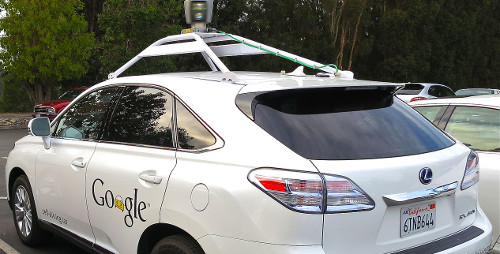
Google plans to make its driverless cars available to the public in three years and, just last week, it invited two dozen journalists to a press briefing on the progress of the automotive technology.
CBR tells you five things you need to know about the technology, competition and business model.
1. How does it work?
Launched in 2009, the vehicles use a modified Lexus RX450h with light detection and ranging technology (LIDAR), which is mounted on the roof and spins constantly to see the world around it. The car’s orientation sensors include lasers and radar technology, which tracks everything around the car at once, while a front camera detects what lies ahead.
All of this information is then fed to an onboard processor that creates a detailed 3D map of the car’s surroundings in real-time, allowing it to navigate safely.
Pre-loaded maps, which include details of the precise location of the curbs and height of traffic lights, are also stored in the car’s memory, so the software knows what to expect before it drives. So far Google has been able to map only 2,000 miles of roads in the US, meaning 99.95% of US roads are yet to be mapped.
Other models of Google’s car include a Toyota Prius and an Audi TT.
2. Is it safe?
Self-driving cars are expected to eliminate 90% of the 33,000 vehicle fatalities a year, according to Larry Burns, a Google consultant and former GM’s VP for R&D.
Back in April, Google posted in a blog that its driverless cars have driven more than 700,000 miles on California roads without any accident.
Recode’s Liz Gannes, one of the journalists invited to the event, said: "I didn’t feel unsafe in the least…The car braked for jaywalkers, paused when it was coming around a curve and couldn’t see whether the light in front of us was green or red, and skittered when it worried that a bus might be turning into our lane."
However, Dmitri Dolgov, the team’s head for software, pointed out that an issue for driverless cars going forward is acclimating sensors to weather conditions, such as rain or snow, elsewhere in the world.
3. What have other people said?
Several journalists have so far described the ride as boringly smooth.
"Generally speaking, the car drove conservatively, a bit like grandparents heading to church," wrote Marco dell Cava of USA Today.
"What made this drive eventful was how utterly uneventful it was. On this predetermined route at least – a route that had been mapped out in detail for the car by Google engineers – there seemed like little chance for drama."
John Markoff’s blog for the New York Times added: "This time our route was even more mundane, basically an uneventful tour through the city streets of a Silicon Valley community."
4. Competition
Google’s driverless car comes as the market for self-driving cars grows increasingly competitive. The likes of Volvo, which is planning to have its self-drive car on Swedish roads, Tesla, Audi, GM and Ford have all said they are working on varying degrees of computer assisted driving technology.
5. Availability
Google co-founder Sergey Brin announced in 2012 that the technology will be available for public in five years, meaning that Google self-driving cars may be usable by 2017.
Project director Chris Urmson was also quoted by Wall Street Journal as saying that a self-driving car is probably still six years away.
"We are thinking now about how to bring this car to market," he said.
The driverless cars do not come cheap and contain $150,000 worth equipment, including a $70,000 laser radar system, something Google expects to drop if the cars were to be developed for a mass market.






